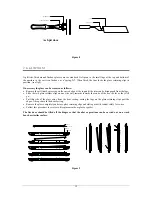
21
For Stratford Si
•
Engage the operating tool on the comb extention.
•
Move up and down vigorously the riddling lever (Ash will fall into the ash pan beneath the grate).
•
When de-ashing is complete re-set grate to previous position.
•
Empty ash pan
The ash pan should be emptied at least twice a day or when the level of ash reaches the top of the pan. On no
account should the ash be allowed to build up to touch the grate as this will greatly shorten its life.
To empty the ash pan
Open the fire door; open the ash door. Fit the fork end of the operating tool into the ash pan and remove from the
ash pit chamber. The ash pan on some large appliances has a pivoted "strap" handle to make carrying easier. This
handle can get very hot and an oven glove or similar should be used.
Warning: The ash can be very hot. Empty only to a metal container. Even if the ash appears cold, red-hot
pieces of ash may be concealed and could easily start a fire or cause an injury. Replace the ash pan and
close ash door. Close the fire down.
Over-firing
Do not over fire your appliance. Using flammable liquids or too much wood or firing the stove at maximum for
prolonged periods may result in over-firing. If the chimney connector or casing glows red it is being over-fired.
If this occurs immediately close all air inlets to the appliance to reduce the air supply to the fire. Should a
chimney fire occur immediately close the appliance down. Get everyone out of the house and call the fire
brigade. A chimney fire may cause a structural damage of the chimney. Do not use the appliance until the
chimney and connector have been inspected and any damaged parts have been repaired or replaced. A chimney
sweep can perform this inspection.
Clinker
The formation of clinker suggests that the unit is being over-fired. Any clinker forming on the grate should be
removed when cold.
15. CLEANING
Important
Under some circumstances soot can quickly build up on the throat plate and adjacent areas. The throat plate
should be removed and checked monthly, and any soot stripped off. Similarly, clean the upper surface of the
firebox.
Refer to page 7 for instructions on throat plate inspection.
It is important that your fire is regularly serviced in accordance with the manufacturers instructions at least
annually by a qualified person and should consist of the following.
Annual Maintenance
Remove the firebricks lining (if fitted), throat plate, grate bars and ash pan. Also inspect all gasketing on doors
glass etc., and re-order any items that may need replacing,
from your Aarrow dealer
. With a wire brush clean
inside the appliance paying particular attention to the small inlet holes of the air wash on the inside, above the
fire door and to the door interlock ensuring free movement of the mechanism exists. Sweep the chimney and
confirm that it is sound. Examine all joints in the flue pipe etc., and re-seal if necessary. Reassemble and leave
with the air inlet and air wash control about half way open. This will allow a free flow of air through the
appliance thus preventing moisture and condensation from building up inside the fire and chimney.
Chimney Sweeping
Sweeping should be carried out with a wire-centred sweep's brush fitted with a guide wheel. As with all
multifuel appliances regular sweeping of the flue is essential to avoid the danger of blockage and the escape of
poisonous fumes.
Any existing chimney should be swept prior to installation of the appliance, and swept again a second time
within one month
of regular use after installation. Sweep the whole flue way, including the outlet, at least twice
per burning season. It is important that the flue ways, flue pipe and chimney be cleaned prior to lighting the fire
after a prolonged shut-down period.
Stop using the appliance if you smell fumes or see smoke escaping.
Summary of Contents for Stratford Sf 30
Page 34: ...34 Manufactured by July 2001...














































